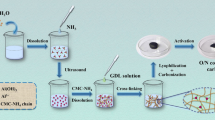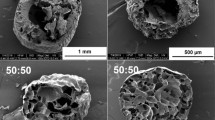Abstract
Activated carbon derived from cellulose with added melamine sulfate, which is known as one of the chemicals having a flame-retardant effect on the cellulose, was produced in order to dope dual hetero elements, such as nitrogen and sulfur, and was used to improve the yields of the carbonization process and carbon dioxide (CO2) activation process. The addition of melamine sulfate resulted in suppression of the BET specific surface area. The Brunauer–Emmett–Teller (BET) specific surface area for the CO2-activated sample with 30 wt.%-added melamine sulfate was 578 m2 g−1. The existence of nitrogen atoms was confirmed in the CO2-activated sample with the added melamine sulfate. However, no peak assigned to the sulfur atom appeared in the x-ray photoelectron spectroscopy spectrum for the sample with the 30 wt.%-added melamine sulfate. In spite of the lower specific surface area of the samples containing the added melamine sulfate, the capacitance values of the carbon material derived from the cellulose with added melamine sulfate were higher than those of the carbon material derived only from cellulose.
Similar content being viewed by others
References
J.M. Dias, M.C.M. Alvim-Ferraz, M.F. Almeida, J. Rivera-Utrilla, and M. Sanchez-Polo, J. Environ. Manag. 85, 833 (2007).
T. Tsubota, D. Nagata, N. Murakami, and T. Ohno, J. Appl. Polym. Sci. 131, 40950 (2014).
T. Tsubota, K. Takenaka, N. Murakami, and T. Ohno, J. Power Sources 196, 10455 (2011).
T. Tsubota, M. Morita, N. Murakami, and T. Ohno, J. Power Sources 267, 635 (2014).
L. Sun, H. Zhou, Y. Li, F. Yu, C. Zhang, X. Liu, and Y. Zhou, Mater. Lett. 189, 107 (2017).
W. Chen, J. Shi, T. Zhu, Q. Wang, J. Qiao, and J. Zhang, Electrochim. Acta 177, 327 (2015).
A.G. Kannan, A. Samuthirapandian, and D.-W. Kim, J. Power Sources 337, 65 (2017).
T. Wei, X. Wei, L. Yang, H. Xiao, Y. Gao, and H. Li, J. Power Sources 331, 373 (2016).
J. Li, G. Zhang, C. Fu, L. Deng, R. Sun, and C.-P. Wong, J. Power Sources 345, 146 (2017).
H.T. Yi, Y.Q. Zhu, X.Y. Chen, and Z.J. Zhang, J. Alloys Compd. 649, 851 (2015).
Y. Li, G. Wang, T. Wei, Z. Fan, and P. Yan, Nano Energy 19, 165 (2016).
T. Akhter, M.M. Islam, S.N. Faisal, E. Haque, A.I. Minett, H.K. Liu, K. Konstantinov, and S.X. Dou, ACS Appl. Mater. Interfaces 8, 2078 (2016).
S. Xiang, X. Yang, X. Lin, C. Chang, H. Que, and M. Li, J. Solid State Electron. 21, 1457 (2017).
C. Chen, W. Fan, Q. Zhang, X. Fu, and H. Wu, Ionics 21, 3233 (2015).
J. Li, G. Zan, and Q. Wu, RSC Adv. 6, 57464 (2016).
T. Tsubota, T. Yamaguchi, C. Wang, Y. Miyauchi, N. Murakami, and T. Ohno, J. Power Sources 227, 24 (2013).
A. Granzow, Acc. Chem. Res. 11, 177 (1978).
H. Konno, T. Ito, M. Ushiro, K. Fushimi, and K. Azumi, J. Power Sources 195, 1739 (2010).
H. Pan, C.K. Poh, Y.P. Feng, and J. Lin, Chem. Mater. 19, 6120 (2007).
H. Pan, J. Li, and Y.P. Feng, Nanoscale Res. Lett. 5, 654 (2010).
M. Kodama, J. Yamashita, Y. Soneda, H. Hatori, and K. Kamegawa, Carbon 45, 1105 (2007).
M. Kawaguchi, A. Itoh, S. Yagi, and H. Oda, J. Power Sources 172, 481 (2007).
J. Gamby, P.L. Taberna, P. Simon, J.F. Fauvarque, and M. Chesneau, J. Power Sources 101, 109 (2001).
D. Hulicova, J. Yamashita, Y. Soneda, H. Hatori, and M. Kodama, Chem. Mater. 17, 1241 (2005).
Acknowledgments
This study was supported by JSPS KAKENHI Grant Number JP 17K06031. The authors are grateful for JSPS.
Author information
Authors and Affiliations
Corresponding author
Electronic supplementary material
Below is the link to the electronic supplementary material.
Rights and permissions
About this article
Cite this article
Tsubota, T., Maguchi, Y., Ishimoto, K. et al. Preparation of Porous Carbon Material Derived from Cellulose with Added Melamine Sulfate and Electrochemical Performance as EDLC Electrode. J. Electron. Mater. 48, 879–886 (2019). https://doi.org/10.1007/s11664-018-6799-z
Received:
Accepted:
Published:
Issue Date:
DOI: https://doi.org/10.1007/s11664-018-6799-z




